Create a column in a SharePoint list or library
SharePoint columns help you group, categorize, and track information, in a list or library. Columns can include content types such as a single line of text, a drop-down list of options, a number that is calculated from other columns, or even the name and picture of a person on your site.
You can also add columns that were created elsewhere on the SharePoint site. When you use an existing column, you're getting the benefit of columns created in other pages.
To delete a page or site column, see Delete a column in a SharePoint list or library.
Note: To create a column for a list or library, you must at least be a member of the default Designers SharePoint group for the site.
Updated Feb 16, 2017 thanks to customer feedback.
Create a simple column in a SharePoint Online list or library
You can add a new column to a list or library in several ways. If you just need a simple text, numeric, or date column, use these steps.
-
Navigate to the list or library you want to create a column in.
-
In the All items view of the list or library you want to add a column, click Quick Edit, and then click Add column
 .
.Note: Does your SharePoint Online screen look different than the examples here? Your administrator may have classic mode set on the list or document library, or you're using an earlier version of SharePoint. If so, click the tab for the SharePoint 2016 version above. See Which version of SharePoint am I using?
-
In the dropdown menu, choose the type of column you want (text, number, person, date, etc).
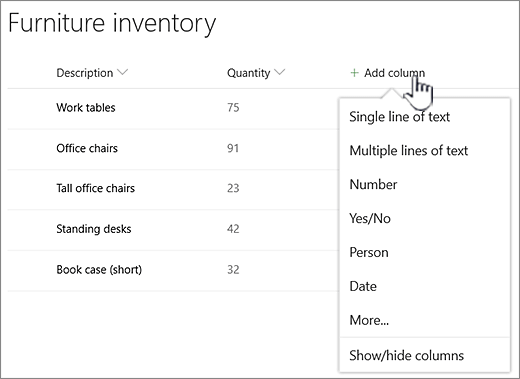
-
In the new column dialog, type a title or column heading into the Name field.
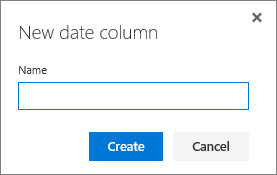
-
Click Create.
Create more types of columns in SharePoint Online
-
Navigate to the list or library where you want to create a column.
-
In the All items or All documents view of the list or library you want to add a column, click Add column
 at the end of the heading row, and then click More ....
at the end of the heading row, and then click More ....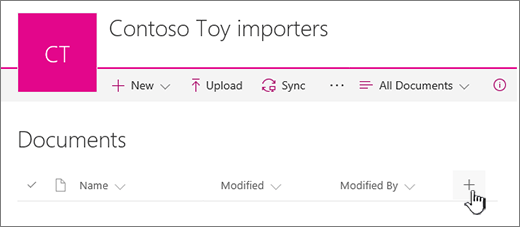
Note: Does your screen look different than the examples here? Your administrator may have classic mode set on the list or document library, or you're using an earlier version of SharePoint. If so, click the tab for the SharePoint 2016 version above. See Which version of SharePoint am I using?
-
In the Name and Type section, type the name that you want for the column in the Column name box.
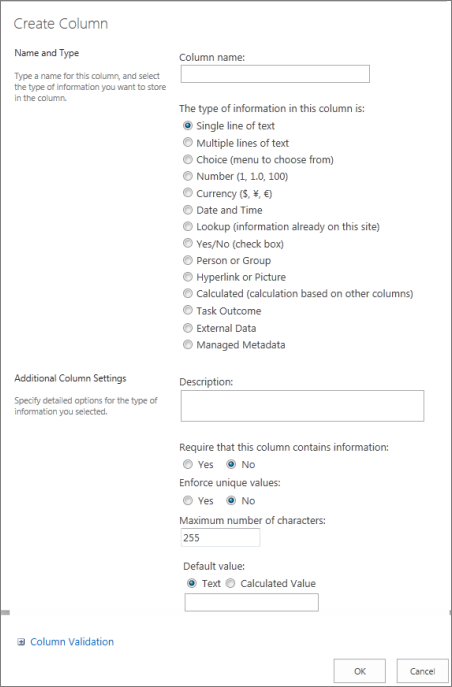
-
Under The type of information in this column is, select the type of information that you want to appear in the column. For more on column types, see Site column types and options.
-
In the Additional Column Settings section, type a description in the Description box to help people understand the purpose of the column and what data it should contain. This description is optional.
Depending on the type of column that you selected, more options may appear in the Additional Column Settings section. Select the additional settings that you want. For more on column settings, see Site column types and options.
-
You can add validation to make sure the column entry matches what's expected. Click Column Validation to expand the section, and type the Formula that you want to use to validate the data. Add a User message that describes what valid data should look like to help users enter valid data. For information on validation and formula syntax see Examples of common formulas in SharePoint Lists.
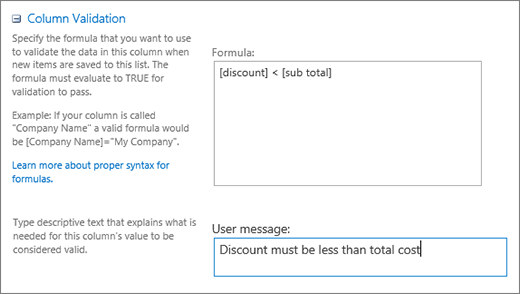
The Column Validation section is not available for all types of columns.
-
Click OK to save.
Create a site column in SharePoint Online
-
On the portal site home page, click Settings
 , and then click Site Settings.
, and then click Site Settings.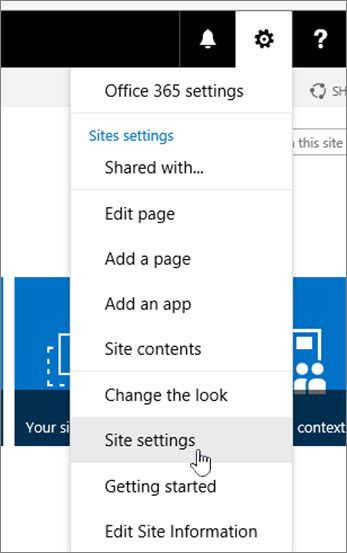
-
On the Site Settings page, under Web Designer Galleries, click Site columns.

-
On the Site Columns page, click Create.
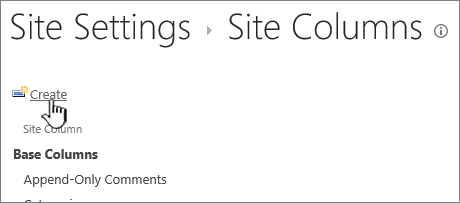
-
In the Name and Type section, type the name that you want in the Column name box.
-
Select the type of information you want to store in the column.
For more on column types, see Site column types and options.
-
In the Group section, select the existing group in which to store the new site column or create a new group to store the column.
The list of Existing groups can vary with version of SharePoint, and what groups have been added.
-
In the Additional Column Settings section, select the additional column settings you want. The options available in this section differ depending on the type of column that you select in the Name and Type section.
For more on column settings, see Site column types and options.
-
Click OK.
Add an existing site column to a SharePoint Online list or library
-
Navigate to the list or library you want to create a column in.
If the name of your list or library does not appear on a page, click Settings
 , click Site Contents, and then click the name of your list or library.
, click Site Contents, and then click the name of your list or library.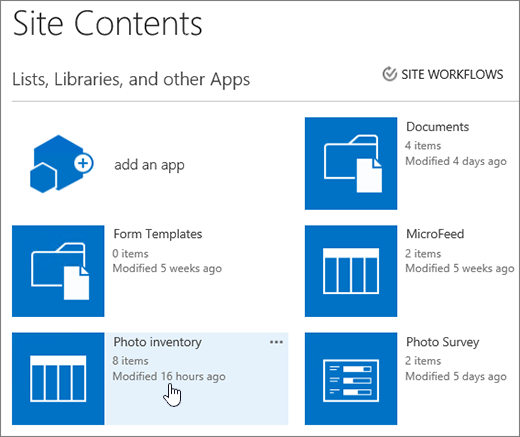
-
Click Settings
 , and then click List settings or Library settings.
, and then click List settings or Library settings.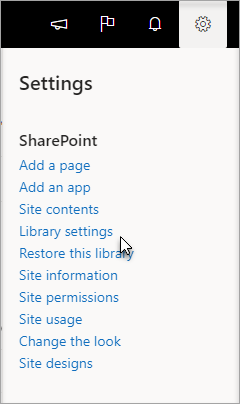
-
On the Settings page, scroll down to the Columns section, and then click Add from existing site columns.

-
On the Add Columns from Site Columns page, in the Select Columns section, select the group of site columns to choose from in the Select site columns from drop-down list.
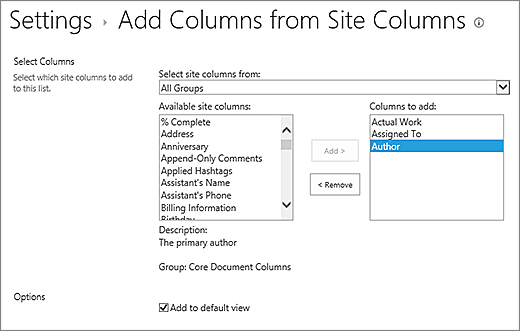
When you select a column group from the list, the available site columns appear in the Available site columns list.
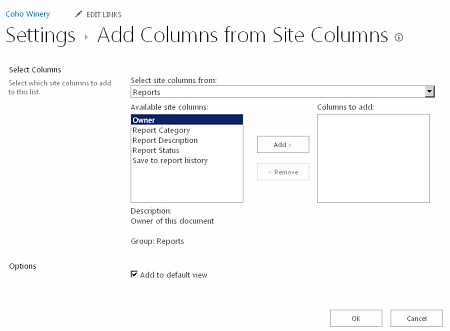
Note: The Available site column list defaults to All Groups, but you can narrow the number of fields by choosing groups that may contain what you're looking for. For example Core Document Columns or Custom Columns.
-
Select the site columns you want to add and click Add. The columns appear in the Columns to add list box. To add the column to the default view, which people on your site automatically see when they first open a list or library, make sure Add to default view is selected. Some lists such as the Tasks list also have the option Add to all content types, which is selected by default. If you want to add the column to all content types, make sure Add to all content types remains selected.
Depending on the type list or library, there may be more settings in the Options section. Select the additional options that you want.
-
Click OK to save.
Create a column in a SharePoint 2016 or 2013 list or library
-
If the list or library is not already open, click its name on the page or in the Quick Launch.
If the name of your list or library does not appear on a page, click Settings
 , click Site Contents, and then click the name of your list or library.
, click Site Contents, and then click the name of your list or library. -
In the ribbon, click the List or Library tab.
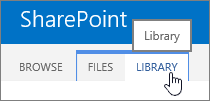
-
In the Manage Views group, click Create Column.
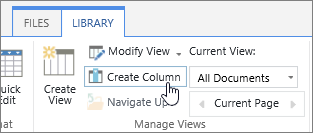
-
In the Name and Type section, type the name that you want for the column in the Column name box.

-
Under The type of information in this column is, select the type of information that you want to appear in the column. For more on column types, see Site column types and options.
-
In the Additional Column Settings section, type a description in the Description box to help people understand the purpose of the column and what data it should contain. This description is optional.
Depending on the type of column that you selected, more options may appear in the Additional Column Settings section. Select the additional settings that you want. For more on column settings, see Site column types and options.
-
You can add validation to make sure the column entry matches what's expected. Click Column Validation to expand the section, and type the Formula that you want to use to validate the data. Add a User message that describes what valid data should look like to help users enter valid data. For information on validation and formula syntax see Examples of common formulas in SharePoint Lists.

The Column Validation section is not available for all types of columns.
-
Click OK to save.
Create a site column in SharePoint 2016 or 2013
-
On the portal site home page, click Settings
 , and then click Site Settings.
, and then click Site Settings. -
On the Site Settings page, under Web Designer Galleries, click Site columns.

-
On the Site Columns page, click Create.

-
In the Name and Type section, type the name that you want in the Column name box.
-
Select the type of information you want to store in the column.
For more on column types, see Site column types and options.
-
In the Group section, select the existing group in which to store the new site column or create a new group to store the column.
The list of Existing groups can vary with version of SharePoint, and what groups have been added.
-
In the Additional Column Settings section, select the additional column settings you want. The options available in this section differ depending on the type of column that you select in the Name and Type section.
For more on column settings, see Site column types and options.
-
Click OK.
Add an existing site column to a SharePoint 2016 or 2013 list or library
-
If the list or library is not already open, click its name on the page or in the Quick Launch.
If the name of your list or library does not appear on a page, click Settings
 , click Site Contents, and then click the name of your list or library.
, click Site Contents, and then click the name of your list or library.
-
In the ribbon, click the List or Library tab.
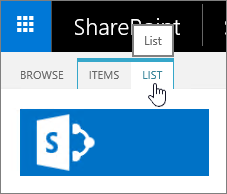
-
In the Settings group, click List Settings or Library Settings.

-
On the Settings page, scroll down to the Columns section, and then click Add from existing site columns.

-
On the Add Columns from Site Columns page, in the Select Columns section, select the group of site columns to choose from in the Select site columns from drop-down list.

Note: The Available site column list defaults to All Groups, but you can narrow the number of fields by choosing groups that may contain what you're looking for. For example Core Document Columns or Custom Columns.
When you select a column group from the list, the available site columns appear in the Available site columns list.

-
Select the site columns you want to add and click Add. The columns appear in the Columns to add list box. To add the column to the default view, which people on your site automatically see when they first open a list or library, make sure Add to default view is selected. Some lists such as the Tasks list also have the option Add to all content types, which is selected by default. If you want to add the column to all content types, make sure Add to all content types remains selected.
Depending on the type list or library, there may be more settings in the Options section. Select the additional options that you want.
-
Click OK to save.
Create a column in a SharePoint 2010 list or library
The following procedure starts from the list or library page to which you want to add the column.
-
If the list or library is not already open, click its name on the Quick Launch. If the name of your list or library does not appear, click Site Actions
 , click View All Site Content, and then click the name of your list or library.
, click View All Site Content, and then click the name of your list or library. -
In the ribbon, click the List or Library tab. The name of the tab may vary depending on the type of list or library. For example, if your list is a calendar, the name of the tab is Calendar.
-
In the Manage Views group, click Create Column.
-
In the Create List dialog box,
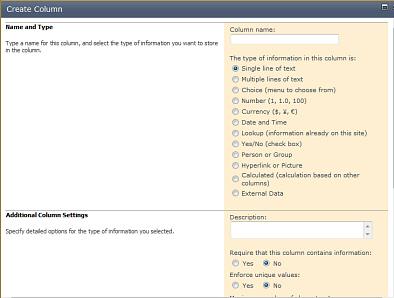
-
In the Name and Type section, type the name that you want for the column in the Column name box.
-
Under The type of information in this column is, select the type of information that you want to appear in the column. For more on column types, see Site column types and options.
Note: Depending on the type of column that you select, you may be unable to change the type of column type after you create it.
-
-
In the Additional Column Settings section, type a description in the Description box to help people understand the purpose of the column and what data it should contain. This description is optional.
Depending on the type of column that you selected, more options may appear in the Additional Column Settings section. Select the additional settings that you want.
-
To add the column to the default view, which people on your site automatically see when they first open a list or library, make sure that Add to default view is selected.
If you want the data in the column validated, in the Column Validation section, type the Formula that you want to use to validate the data, and type the User message that you want to proved users to help them type valid data. The Column Validation section is not available for all types of columns.
-
Click OK.
Create a site column in SharePoint 2010
-
Click Site Actions
 , and then click Site Settings.
, and then click Site Settings.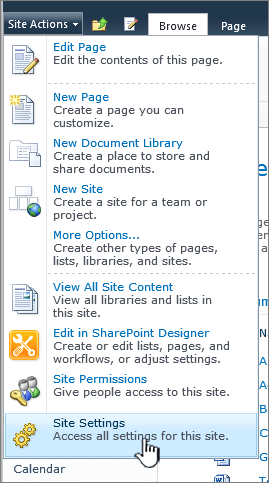
-
On the Site Settings page, under Galleries, click Site columns.

-
On the Site Columns page, click Create.

-
In the Name and Type section, type the name that you want in the Column name box.
-
Select the type of information you want to store in the column.
For more on column types, see Site column types and options.
-
In the Group section, select the existing group in which to store the new site column or create a new group to store the column.
The list of Existing groups can vary with version of SharePoint, and what groups have been added.
-
In the Additional Column Settings section, select the additional column settings you want. The options available in this section differ depending on the type of column that you select in the Name and Type section.
For more on column settings, see Site column types and options.
-
Click OK.
Add a site column to a SharePoint 2010 list or library
-
If the list or library is not already open, click its name on the Quick Launch.
If the name of your list or library does not appear, click Site Actions
 , click View All Site Content, and then click the name of your list or library.
, click View All Site Content, and then click the name of your list or library. -
In the ribbon, click the List or Library tab. The name of the tab may vary depending on the type of list or library. For example, if your list is a calendar, the name of the tab is Calendar.
-
In the Settings group, click List Settings or Library Settings.
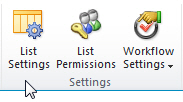
-
On the List Settings or Library Settings page, scroll down to the Columns section, click Add from existing site columns.

-
On the Columns from Site Columns page, in the Select Columns section, select a column in the Available site columns list, and then click Add.
When you select a column in Available site columns, the group the column is in and a description are displayed if available.
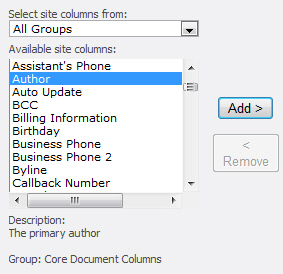
Note: The Available site column list defaults to All Groups, but you can narrow the number of fields by choosing groups that may contain what you're looking for. For example Core Document Columns or Custom Columns.
-
To add the column to the default view, which people on your site automatically see when they first open a list or library, make sure Add to default view is selected.
Depending on the type list or library, there may be more settings in the Options section. Select the additional options that you want.
-
Click OK.
Change the settings for a column in a SharePoint 2010 list or library
You can change the settings for a column, such as the name of the column. Depending on the type of column and the type of list, you can make additional changes, such as how much text a user can enter. Programs such as SharePoint Designer 2010 offer even more options for modifying columns, such as specifying the column width.
-
If the list or library is not already open, click its name on the Quick Launch.
If the name of your list or library does not appear, click Site Actions
 , click View All Site Content, and then click the name of your list or library.
, click View All Site Content, and then click the name of your list or library. -
In the Ribbon, click the List or Library tab. The name of the tab may vary depending on the type of list or library. For example, if your list is a calendar, the name of the tab is Calendar.
-
In the Settings group, click List Settings or Library Settings.

-
On the List Settings or Library Settings page, in the Columns section, click the name of the column that you want to change.
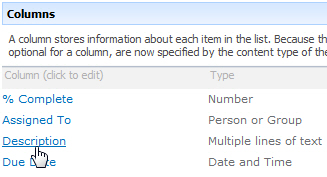
-
Change the settings that you want, and then click OK.
Create a column in a SharePoint 2007 list or library
Note: The following procedure begins from the list or library page to which you want to add the column. If the list or library is not already open, click its name on the Quick Launch. If the name of your list or library does not appear, click View All Site Content, and then click the name of your list or library.
-
If the list or library is not already open, click its name on the Quick Launch. If your list or library isn't there, click Site Actions
 , click View All Site Content, and then click the name of your list or library.
, click View All Site Content, and then click the name of your list or library.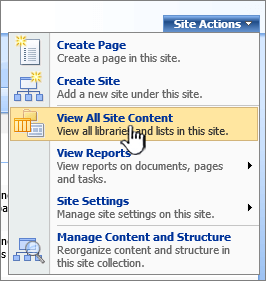
-
On the Settings menu
 , click Create Column.
, click Create Column. -
In the Name and Type section, type the name that you want in the Column name box.
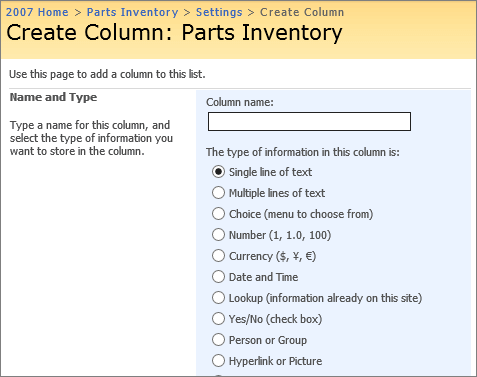
-
Under The type of information in this column is, select the type of information that you want to appear in the column. For more on column types, see Site column types and options.
-
In the Additional Column Settings section, type a description in the Description box to help people understand the purpose of the column and what data it should contain. This description is optional.
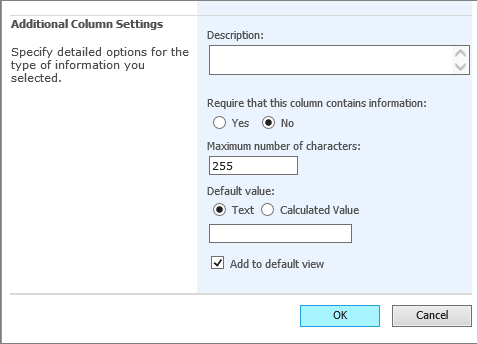
-
Depending on the type of column that you selected, more options may appear in the Additional Column Settings section. Select the additional settings that you want.
-
To add the column to the default view, which people on your site automatically see when they first open a list or library, click Add to default view.
-
Click OK.
Change the settings for a column in SharePoint 2007
You can change the settings for a column, such as the name of the column. Depending on the type of column and the type of list, you can make additional changes, such as the amount of text a user can enter.
-
If the list or library is not already open, click its name on the Quick Launch.
If the name of your list or library does not appear, click View All Site Content, and then click the name of your list or library.
-
Do one of the following:
-
On the Settings menu
 , click List Settings or the settings option that you want.
, click List Settings or the settings option that you want. -
On a blog site, under Admin Links, click Manage Posts to display the posts list. On the Settings menu, click List Settings.
-
-
Under Columns, click the name of the column that you want to change.
-
Change the settings that you want, and then click OK.
Note: You can specify that a column is indexed, which can make it faster to switch views of lists or libraries that span multiple folders. To view the settings for a list or library, on the main page for customizing settings, click Indexed Columns. Select the column that you want to index, and then click OK. For more info on indexes, see Manage large lists and libraries in SharePoint.
Create a site column in SharePoint 2007
A site column is a reusable column definition, or template, that you can assign to multiple lists across multiple SharePoint sites. Site columns are useful if your organization wants to establish some consistent settings across lists and libraries. You can share the settings across multiple lists and libraries so that you don't have to re-create the settings each time.
-
On the portal site home page, click Site actions, point to Site Settings, and then click Modify All Site Settings.
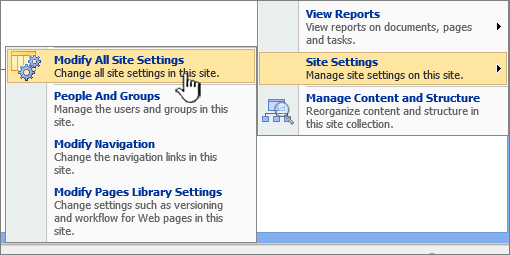
-
On the Site Settings page, under Galleries, click Site columns.
-
On the Site Column Gallery page, click Create.
-
In the Name and Type section, type the name that you want in the Column name box.

-
Under The type of information in this column is, select the type of information that you want to appear in the column.
For more on column types, see Site column types and options.
-
In the Group section, select the existing group in which to store the new site column or create a new group to store the column.
The list of Existing groups can vary with version of SharePoint, and what groups have been added.
The following table describes the groups that are available by default.
Select this
To display this
Base Columns
Columns that are useful in many types of lists or libraries.
Core Contact and Calendar Columns
Columns that are useful in contact and calendar lists. These columns are typically used to synchronize metadata from client contact and calendar programs, such as Microsoft Outlook.
Core Document Columns
Standard document columns from the Microsoft Office core property set and the Dublin Core Metadata Set.
Core Task and Issue Columns
Columns that are useful in task and issues lists. These columns are typically used to synchronize metadata from client Task and Issue programs, such as Office Outlook.
Custom Columns
Columns that you add to suit the purpose of your list or library.
Extended Columns
A set of special-purpose columns.
Key Performance Indicators
Columns that are useful for displaying key performance indicator data.
Page Layout Columns
Columns that are useful for containing page layout information.
Publishing Columns
Columns that are useful for containing publishing information.
Reports
Columns that are useful for creating reports.
-
In the Additional Column Settings section, type a description in the Description box to help people understand the purpose of the column and what data it should contain. This description is optional.

-
Depending on the type of column that you selected, more options may appear in the Additional Column Settings section. Select the additional settings that you want.
-
Click OK.
More you can do with columns
-
To change a column to a list or library, see Change a column in a list or library.
-
To delete a column and its data from a list or library, see Delete a column from a list or library.
-
For an alternative to deleting a column from a page or site, see Show or hide a column in a list or library on a page.
-
To get some ideas on how to manage a list or library with many items, see Manage lists and libraries with many items.
-
To add a list to a page or site, see Create a list in SharePoint.
-
To delete a list from a page or site, see Delete a list from SharePoint.
We're listening!
Was this article helpful? If so, please let us know at the bottom of this page. Let us know what was confusing or missing. If you got here from a search and it wasn't the information you wanted, let us know what you were searching for. Please include your SharePoint, OS, and browser versions. We'll use your feedback to double-check the steps and update this article.
No comments:
Post a Comment